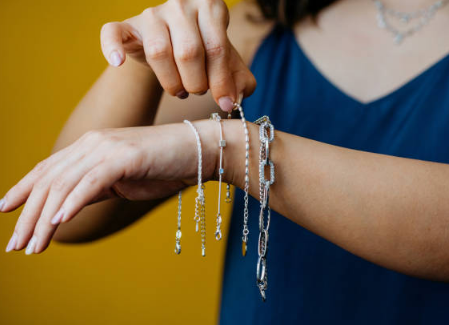One of the most common complaints about silver jewelry is that it can darken over time. Can you prevent this from happening? How should you remove black stains from your silver jewelry?
Why Does Silver Change Color?
After each piece of silver jewelry has been used for a certain period of time, a black coating will form on its surface. This tarnishing is the result of a chemical reaction that occurs when silver comes into contact with air and various substances.

Silver tarnish is a form of corrosion, but unlike rust, it does not destroy the metal underneath and can be removed relatively easily.
How Can I Prevent Silver from Discoloring?
There is no way to prevent your silver jewelry from turning black because silver reacts with many materials in everyday life.
For example, exposure to tap water (because it contains chlorine), many foods (such as salad dressings), perfumes and hairsprays, and even woolen clothes, can accelerate tarnishing.
While tarnishing is a natural process that can’t be stopped, it can slow it down, but at some point you’ll still need to clean the tarnished layer.
Stops Tarnishing
To slow down discoloration, clean your silver jewelry after wearing. The oil on the skin can accumulate on the surface of the silver, making it susceptible to oxidation.
Gently wash your jewelry with warm water and dry it with a soft cloth.
You can also delay tarnishing by polishing your silver jewelry regularly. As soon as you show signs of discoloration, use a polishing cloth to clean the silverware.
Alternatively, you can have your silver jewelry polished by a professional.
Minimize the contact of silver jewelry with substances that may cause discoloration. This means that you should not wear silver jewelry in the bath or bath.
Don’t forget to take off your silver ring while cooking. Also, avoid pairing silver necklaces with woolen clothes.
Latex is another substance that can accelerate discoloration, so you should avoid silver coming into contact with it.
And don’t forget to wear jewelry only after you’ve put on makeup and sprayed perfume.

How to Clean Silver Rust
When the silverware has lost its luster, you can use a silverware polish to remove the black coating. This rust removal polishing paste is popular and can be used on silverware.
Another option is to use a silver polishing cloth.
You can also take your silverware to a jewelry store for professional cleaning.
If you prefer to clean your silver jewelry at home, you can use a silver jewelry cleaner:
- Line the glass container with tin foil, pour in some hot water, and add a tablespoon or two of salt and baking soda.
- Place the silver sheet in the immersion solution and leave it for about five minutes.
- Once the rust is gone, rinse the jewelry with water and dry it with a soft cloth.
Some people use toothpaste to clean their silverware. However, there are also warnings against using this method, as toothpaste is too abrasive and can scratch your jewelry. In general, it depends on the softness of the silver alloy and the type of toothpaste used, as some brands of toothpaste are more abrasive than others. If your silverware has a flat surface and scratches are easy to see, you may not want to risk using this method.
Silver-Plated: Temporary Protection
Many of the silver items sold today are electroplated to prevent discoloration. The metals used for coating are usually sterling silver and rhodium.
This process of plating silver with a layer of white metal is called “glitter”.
The disadvantage of silver plating is that the coating will eventually wear out. The more you wear and polish your silverware, the faster this will happen.
When the plating is gone, you can re-plate your jewelry.
Store Silver to Delay Discoloration
In general, to slow down the process of tarnishing, you should store your silver jewelry in a way that limits its exposure to air and humidity.
Place your silverware in a sealed bag and close tightly. You can also put a silicone bag inside, as well as your jewelry. These small silicone pouches absorb moisture, which helps delay discoloration.
